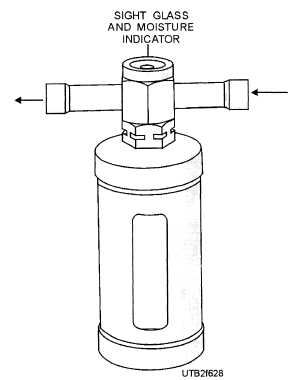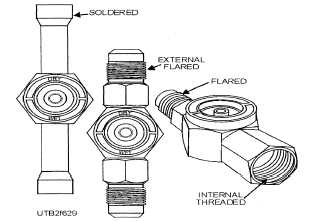pressure in the evaporator then activates the low-pressure switch, which stops the compressor. As the temperature rises, the increase in bulb pressure closes the switch contacts, and the refrigerant is supplied to the expansion valve.
LIQUID LINE. - The refrigerant accumulated in the bottom of the receiver shell is conveyed to the cooling coils through the main refrigerant liquid line. A stop valve and thermometer are usually installed in this line next to the receiver. Where the sight-flow indicator, dehydrator, or filter-drier is close to the receiver, the built-in shutoff valves may be used instead of a separate shutoff valve.
LIQUID LINE FILTER - DRIER OR DEHYDRATOR. - A liquid line filter-drier (fig. 6-28) prevents or removes moisture, dirt, and other foreign materials from the liquid line that would harm the system components and reduce efficiency. This tank like accessory offers some resistance to flow. and, for this reason, some manufacturers install it in a bypass line. A filter-drier consists of a tubular shell with strainers on the inlet and outlet connections to prevent escape of drying material into the system. Some filter-driers are equipped with a sight-glass indicator, as shown in figure 6-28. A dehydrator is similar to a filter-drier, except that it mainly removes moisture.

Figure 6-28. - A liquid line filter-drier with sight-glass indicator.
SIGHT-FLOW INDICATOR. - The sight-flow indicator, also known as a sight glass (fig. 6-29), is a special fitting provided with a gasketed glass, single or double port, and furnished with or without seal caps for protection when not in use. The double-port unit permits the use of a flashlight background. The refrigerant may be viewed passing through the pipe to determine the presence and amount of vapor bubbles in the liquid that would indicate low refrigerant or unfavorable operating conditions. Some filter-driers are equipped with built-in sight-flow indicators, as shown in figure 6-29.
SUCTION LINE. - Suction pressure regulators are sometimes placed between the outlet of the evaporator and the compressor to prevent the evaporator pressure from being drawn down below a predetermined level despite load fluctuations. These regulators are usually installed in systems that require a higher evaporator temperature than usual.
PRESSURE CONTROL SWITCHES. - Pressure control switches (fig. 6-30), often called low-pressure cutouts, are essentially a single-pole, single-throw electrical switch and are mainly used to control starting and stopping of the compressor. The suction pressure acts on the bellows of the power element of the switch and produces movement of a lever mechanism operating electrical contacts. A rise in pressure closes the switch contacts and thereby completes the circuit of the motor controller, which, in turn, starts the compressor automatically. As the operation of the compressor gradually decreases the suction pressure, the movement of the switch linkage

Figure 6-29. - Sight-flow indicators with different types of connections.
Continue Reading